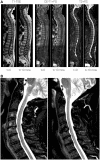First Report of IgG4 Related Disease Primary Presenting as Vertebral Bone Marrow Lesions
- PMID: 31456806
- PMCID: PMC6700296
- DOI: 10.3389/fimmu.2019.01910
First Report of IgG4 Related Disease Primary Presenting as Vertebral Bone Marrow Lesions
Abstract
IgG4-related disease is a fibro-inflammatory disorder characterized by swelling of tissues and affected organs accompanied by the development of scar tissue (fibrosis) and infiltration by IgG4 positive plasma cells. Almost any organ can be affected, including, but rarely, bone marrowinvolvement. Here we present a case of a 76-year-old male with IgG4-related disease presenting primarily with vertebral bone marrow lesions. Histopathology showed the typical features of storiform fibrosis, and increased IgG4 positive plasma cells. Treatment with corticosteroids significantly improved wellbeing and resolved lesion size on MRI.
Keywords: IgG4-related disease; MRI; bone marrow; histology; immunhistochemistry; plasma cell; spine; vertebra.
Figures


References
Publication types
MeSH terms
LinkOut - more resources
Full Text Sources
Medical

